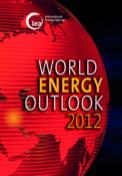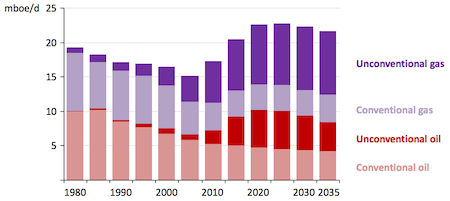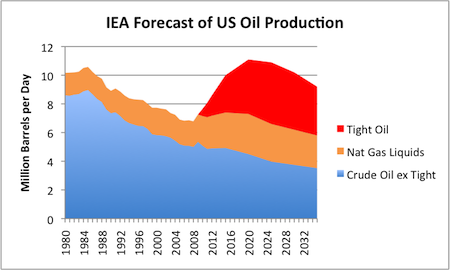Why the IEA’s 2012 World Energy Outlook Could Be Wrong

 “Prediction is very difficult, especially about the future.” The Danish physicist Niels Bohr first said this, and it’s true. Of course, we all like to try anyway, and I’ve done so myself with my articles on peak oil and the end of growth. I could well be wrong. It’s happened before. But the International Energy Agency (IEA), I believe, runs a greater risk of being wrong with its prediction that the US will become the world’s largest oil producer by 2020 and energy independent by 2030 in their 2012 World Energy Outlook (WEO).
“Prediction is very difficult, especially about the future.” The Danish physicist Niels Bohr first said this, and it’s true. Of course, we all like to try anyway, and I’ve done so myself with my articles on peak oil and the end of growth. I could well be wrong. It’s happened before. But the International Energy Agency (IEA), I believe, runs a greater risk of being wrong with its prediction that the US will become the world’s largest oil producer by 2020 and energy independent by 2030 in their 2012 World Energy Outlook (WEO).
“Prediction is very difficult, especially about the future.” The Danish physicist Niels Bohr first said this, and it’s true. Of course, we all like to try anyway, and I’ve done so myself with my articles on peak oil and the end of growth. I could well be wrong. It’s happened before. But the International Energy Agency (IEA), I believe, runs a greater risk of being wrong with its prediction that the US will become the world’s largest oil producer by 2020 and energy independent by 2030 in their 2012 World Energy Outlook (WEO).
I don’t keep up with the day-to-day peak oil discussions the way I did 7 or 8 years ago, but when I need to find out what the peak oil community thinks about a topic, I know where to turn. Two of the people who write well informed articles about this are Stuart Staniford (another physicist) and Gail Tverberg (an actuary). They’re pretty good with numbers, and they’ve got some analysis of the 2012 WEO predictions. Here’s what they say.
Staniford, whose blog is called Early Warning – Rational Analysis of Global Civilizational Risk, wrote an article earlier this week about the IEA’s prediction. He’s one of the smartest people I know who writes about peak oil, and he always takes an objective look at the data. His first take on the prediction is:
I am less persuaded myself that using a thousand oil rigs to generate an extra one million barrels per day of oil is necessarily a sign of a large and long-term sustainable increase in US oil production (as opposed to, say, frenzied scraping of the bottom of the barrel). But, still, I’m not certain beyond a reasonable doubt just how deep this particular barrel can be scraped.
Then he makes an interesting point about the data that you won’t hear in the mainstream media. If the US is going to take the lead by hitting 10 million barrels per day (mbd) of oil production, he suggests, that means the IEA sees Russia and Saudi Arabia dropping, or at best staying about where they are. They’re currently at 10.75 mbd and 9.5 mbd, respectively.
Staniford also showed a chart (below) of where the new production is coming from, illustrating that it’s not the easy, conventional oil we’re used to. Conventional oil and gas are continuing their decline.
Tverberg, in her article at The Oil Drum, points out that the we’re not talking about conventional oil here, and the costs to get it are high. Her main contention is that, because of the diminishing returns associated with unconventional sources like the Bakken formation in North Dakota, costs will be higher than the IEA predicts. She goes into great detail about the nature of the diminishing returns in her Oil Drum post, which is an abridged version of the article on her own blog, Our Finite World.
I think the truth here is that the IEA’s prediction that the US will lead the world in oil production is overly optimistic. “The statements about rising oil production in the US are just a distraction,” Tverberg wrote. The more restrained Staniford paints it as an act of desperation: “Apparently the agencies have now accepted that Saudi Arabia cannot or will not increase production and the US is now being assigned the role of supplier of last resort for future energy projections.”
It’s also interesting that suddenly the news is flooded with this report of an oil bonanza. Just two years ago, the big news was that the US military was predicting oil shortages by the year 2015. Surely our military strategists wouldn’t have missed something so big that it could turn their prediction upside down in a short two years.
Time will tell which side is right.
Related Articles
The End of Growth – Mathematics & Peak Oil
Has the Long Emergency Begun? Peak Oil and the Economic Downturn
Declining Oil Discoveries – The Truth Behind Peak Oil
Image credits: First chart from Stuart Staniford’s Early Warning article. Second chart from Gail Tverberg’s Our Finite World aricle.
This Post Has 7 Comments
Comments are closed.



Well yes military stategists
Well yes military stategists can be completely, totally wrong. Think about the Maginot Line as a military strategy.
The IEA could be wrong also, forecasting is notoriously difficult. The takeaway I see is, there ARE significant changes in the geology and technology being used, and it all is a step away from the fear which is promoted by peak-oil enthusiasts. There is something weirdly stimulating about predicting the end of civilization… and I think the endocrine system plays some role in the patterns of the various Chicken Little theories (of which there are many).
M. Johnson
M. Johnson: What I find even more interesting is the pie-in-the-sky psychology of people who believe the party can go on forever. To your point about predicting the end of civilization, though, yes, there are some peak oilers who do that, but most of us believe that it means significant change from the way we’ve lived for the past century. Collapse is one possible scenario but not inevitable.
Funny, I don’t give any
Funny, I don’t give any weight to the IEA’s predictions on fossil fuel production, so I ignored the whole kerfuffle over the 2012 report’s US production estimates.
What intrigued me much more was the report’s indication that over two-thirds of fossil fuel reserves must remain in the ground. Nice to see them coming around to this. At the other end of the spectrum is 350.org saying that four-fifths must remain in the ground. So perhaps the real answer lies somewhere in between.
I’m rather new to the peak
I’m rather new to the peak oil world, having my interest in it piqued (pun not intended but inevitable) by this very blog, which contained a link to Al Bartlett’s talks on the subject. I have also read “The Long Emergency” (TLE), spent time on peakoil.com and theoildrum.com. Therefore I’m already seeing a healthy variety of what the significance of peak oil may be, ranging from exponetial growth is sustainable forever regardless of any data to the contrary (thereby negating peak oil) to TLE’s “we’re screwed, so get ready” essence. To study this subject thoroughly I believe it’s necessary to understand the extents of the peak oil spectrum.
At this point I would say we’re in for some bumpy weather ahead, but as for it being “we’re screwed, so get ready”, that depends on how well we can transition from finite to renewables, if that’s even possible with current levels of world population growth. I do know, without citing countless sources, that our current way of living here in the USA is NOT perpetually sustainable. Industry and population cannot grow forever without consequence.
I also, from the moment I first heard the IEA story break on the news, felt from the start that something wasn’t right about it. I’m glad to see you include this discussion in your blog, as it really merits discussion, beyond mere academic ponderance.
Hi Allison,
Hi Allison,
I think this is a good summary post…
To be sure, there is a lot of “white noise” out there these days and it is difficult to filter through it all for what might actually be something like truth, so it is good to see people like yourself making the effort to present balanced summaries.
Have you seen Tom Murphy’s post on “Ruthless extrapolation”?
http://physics.ucsd.edu/do-the-math/2012/06/ruthless-extrapolation/
Of course, “ruthless extrapolation” cuts boths ways, but it seems to be in very common use with proponents of BAU.
Personally, I always get suspicious about anything that seems to be built on a tower of “ifs” (like a large-scale build out of renewable energy infrastructure).
I think it is wise to be unassuming about anthing to do with the future.
David E.:
David E.: Yes, those of us who see the bigger picture and understand the role of organizations like the IEA usually know not to take their prognostications too seriously. Many people don’t know that, however, and my post here is to help put things in perspective.
Cameron T.: Even more important than moving to renewables, perhaps, is figuring out how to use less energy overall.
Lucas D.: Thanks for the link to Tom Murphy’s article. I hadn’t seen that one. For those who want to check it out, here’s a clickable link:
Ruthless Extrapolation
.
Energy independence by
Energy independence by increased production of oil and gas is simply not sustainable. It must and will run out eventually. North American self sufficiency is possible but it requires a steady reduction in fossil fuel use and a steady switch to sustainable and renewable sources of energy. This may require major changes in lifestyle but growth in the meantime should not be curtailed. Rising prices for oil and gas should effect most necessary changes in time but may not happen without some intermediate crises in supply.